A TRAMWAY at Saint-Tropez :

The roads of the Gulf of Saint Tropez are totally saturated in summer and begin to be saturated the rest of the year. The infrastructure has not changed despite the creation of Port Grimaud, Port Cogolin, Des Marines de Gassin and all the residential developments that have sprung up in the last 30 years from Saint Tropez to Sainte Maxime. Neither the communes nor the department have been able or willing to solve this problem. The large roundabout of La Foux, heart of the gulf, should have been redesigned to avoid its congestion. Sainte Maxime has never created a detour route. Saint Tropez is a totally saturated cul-de-sac... Hence the idea that was put forward a few years ago to recreate a TRAMWAY in order to facilitate travel between the different villages of the gulf and the beaches of the seaside ...
From 1889 to 1949, a train and a tramway have promoted tourism and movement of inhabitants in the Gulf of Saint Tropez ...
History of the LITTORAL TRAIN
Between TOULON and SAINT RAPHAEL
It was in 1852 that the idea of a railroad linking Toulon to Saint Raphael was first mentioned to the Ministry of Public Works. At that time the department of Var extended to the river from which it took its name, this river delimiting the border between Provence and County of Nice, for 5 centuries. When in 1860, Nice was attached to France, the Var lost the district of Grasse which joined that of Nice to form the new department of the Alpes Maritimes.
The Toulon-Les Arcs line on September 1, 1862 and the Arcs-Saint Raphaël line on April 10, 1863.
The Toulon-Hyères line was completed on July 10, 1876.
Finally, at the April 10, 1978 session of the General Council of the Var, the idea of extending the Salin d'Hyères line to Fréjus via the Gulf of Saint Tropez was seriously discussed. But until 1880, the French State was not willing to finance a normal way line of general interest on the Var coastline.
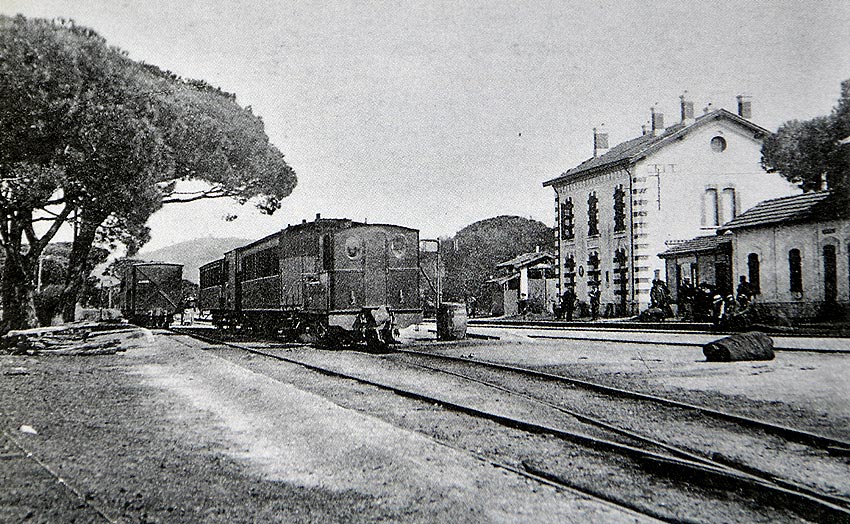
'la Foux / Saint Tropez' station

Saint Pons station
Local interest railways
On June 11, 1880, a new law established the category of "local interest railways", making it possible to build lines that were technically more economical, with financial participation from the departments granting the concessions (and no longer from the state), local authorities and private interests.
Many projects of line were proposed until that of Mr. SILHOL which he deposited on September 1, 1883 at the General Council and which envisaged a line starting from Toulon, passing by Hyères and skirting the littoral to Fréjus. Great novelty of this project, to compensate for the additional cost of the line due to an increase in length, the track would not be normal but narrow at the gauge of one meter., which lowered its construction and operating costs by 30 to 40%.
Mr. SILHOL surprisingly did not show up again and it was later learned that a well-known banker at the time, Mr. De Reinach, compensated him handsomely for withdrawing in favor of another group in which he held many interests.
|
The "CÔTE d'AZUR"
The name "Côte d'Azur" was invented by the sub-prefect poet and dandy Stephen Liegeard in his book on this region entitled "La Côte d'Azur" (1887), perhaps thinking of its original department, the "Côte d'Or", replacing that of "Rivièra" (this expression Riviera is still used in Italy and by the English!). The word "Côte d'Azur" entered the dictionary a year later as a result of this book.
|
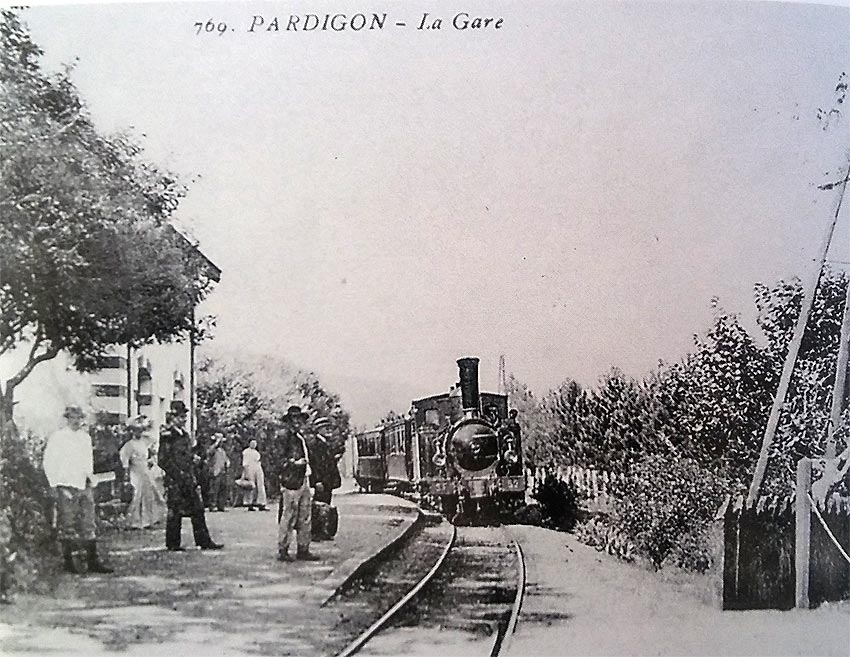
Stations will be built all along the line....
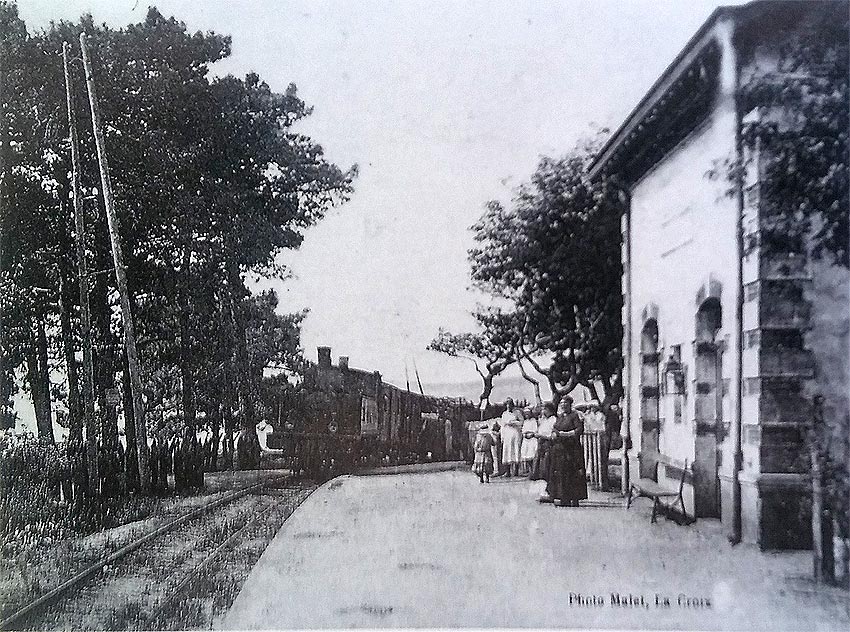
Félix MARTIN
Another important person whose name remains attached to the train of the coast, Félix MARTIN, mayor of Saint Raphael, great 'megalomaniac' who transformed his Provencal village into a real scenery, by retracing the boulevards, establishing the casino, a circle, the church, the post office...
But Félix MARTIN remains the man who invented the 'B>Côte d'Azur'. He liked to think big and had the idea of a railway that would attract many tourists to the coast, and he tried to convince the Baron de REINACH to give him financial support by becoming a shareholder of his Société des Terrains du Littoral.
This company purchased land on the seafront with soil unsuitable for cultivation in order to establish future resort subdivisions. These plots of land purchased 1F per m2 will be resold up to 80F once the train is in service.
In the spring of 1884, the Société des Ponts & Travaux en Fer (SPTF), of which Baron de Reinach was a shareholder, represented the SILHOL project at the General Council.
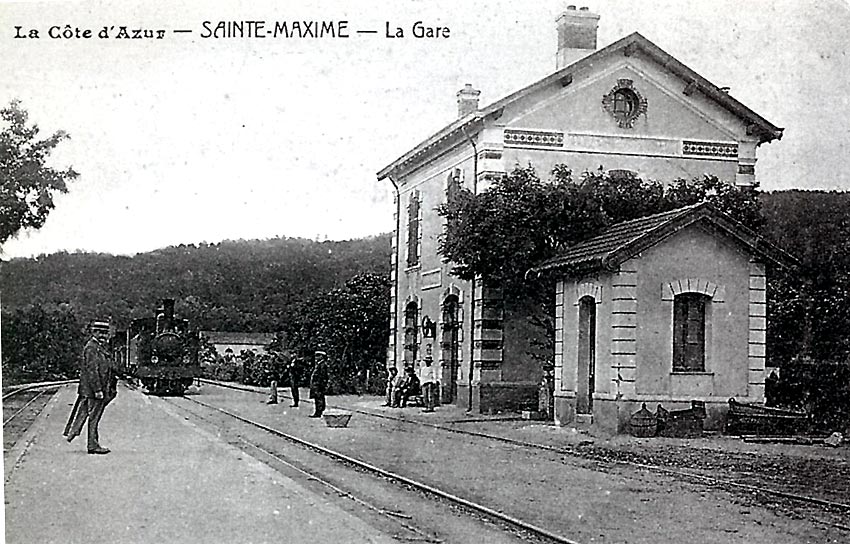
Sainte Maxime station
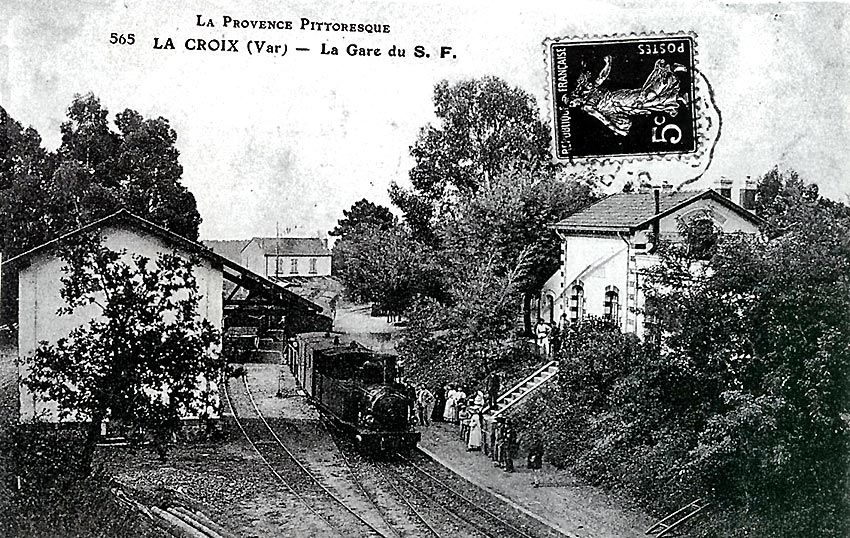
Croix-Valmer station
First section
This first section largely followed the coastal road and did not require important earthworks except in the rocky sector of Issambres and Saint Aygulf where explosives had to be used. Numerous bridges with metal deck were built, on the Giscle, the Vallon des Mures, the Préconil, the Garonnette and the Gaillarde. The Eiffel company had to use an original technique to build 5 bridges in order to cross the vast flood plain at the mouth of the Argens, Reyans and Villepey ponds, due to the shifting nature of the sandy bottoms. Between La Foux and Hyères, the rocky nature of the route forced numerous earthworks and the digging of 4 tunnels.
From August 13 to 18, 1889, after completion of the line, its exact measurement was carried out: two men traveled the route from Saint Raphaël-La Foux with 5m. long wooden rulers: they obtained 29,637m.
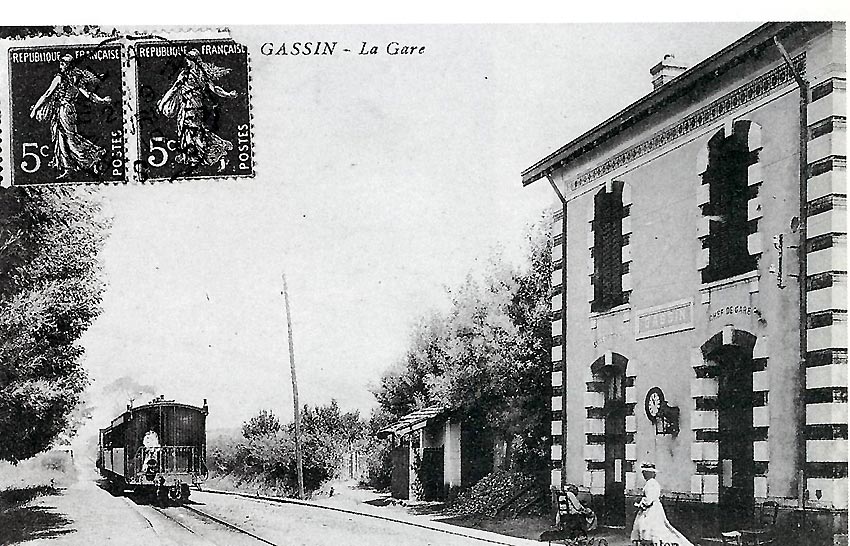
Gassin station
Speculation and bribes
On 19 September 1884, the prefect of the Var and the director of SPTF signed the concession agreement.
Félix MARTIN was in charge of the study and construction of the future line. On December 3, 1885, a new and more appropriate company replaced the SPTF to build and operate the future network, the Compagnie des Chemins de Fer du Sud de la France. (SF)
On April 17, 1886, the National Assembly declared the Toulon-Saint Raphaël local-interest railway to be in the public interest. A decree of the President of the Republic, Jules GREVY, on July 22, 1860, confirmed this declaration.
A decree of March 19, 1887 ratified the transfer of the SPTF concession to the SF. Construction could not begin without provoking a great deal of controversy over the rather favorable conditions granted to the concessionaire, judging the traffic forecasts too exaggerated and especially emphasizing that the route would favor speculation on land held by owners with close ties to the SF. Faced with these detractors, the Mayor of Saint Tropez, Mr. CHAMPMORIN, and the Mayor of the Plan de la Tour, Dr. SIGALLAS, created the Comité des Intérêts du Littoral du Var to support the project.
After some rather strange negotiations and many bribes paid to obtain the contract award, work finally began in March 1888 on the first lot La Foux- Saint Raphael.
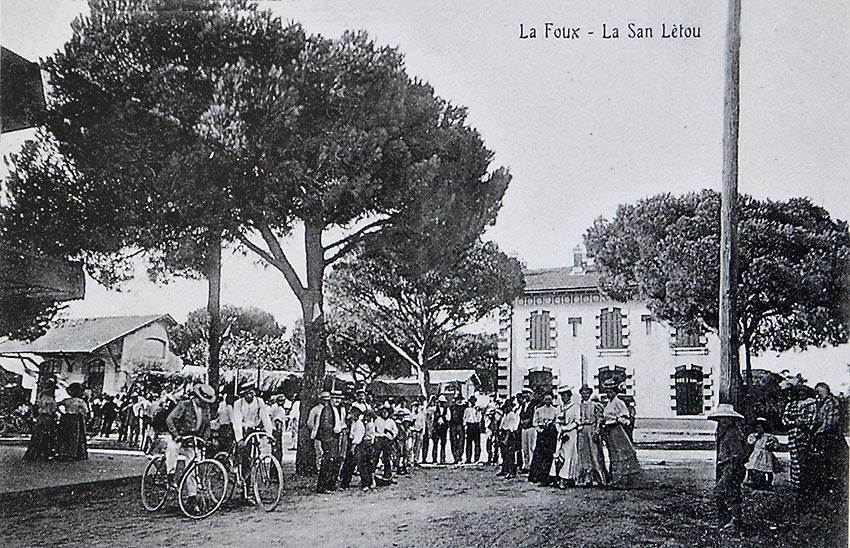
The station of La Foux was next to the Hippodrome from where a big influx of travellers, especially in summer
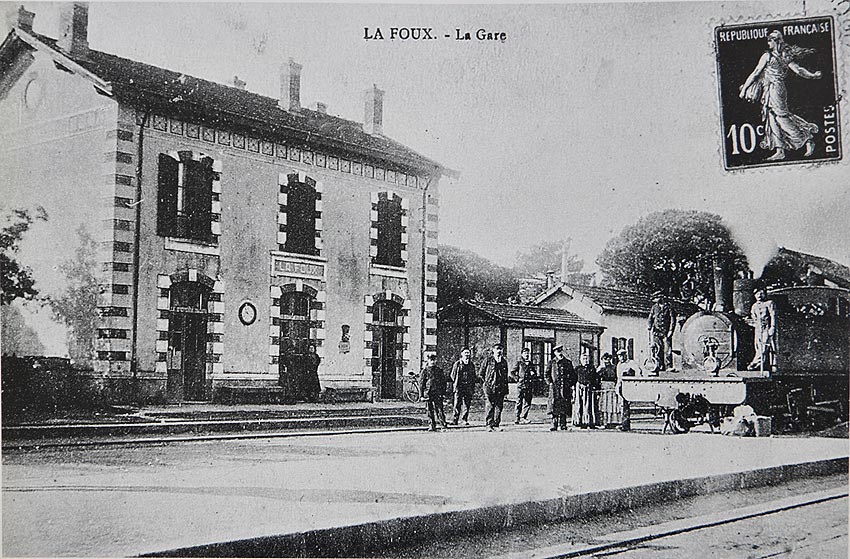
|
Hippolyte ADAM
An adventurer on the wild Var shores
In 1850, Hippolyte Adam, descendant of a rich industrial family from Boulogne-sur-Mer, and Mayor of the town of Outreau in the north, learned that a train line was going to be built along the Var coast. Flairant of the good financial deal, he bought on plan, for a pittance, a large number of uninhabited lands on which the railway line was theoretically to pass, which he sold at a golden price to the Compagnie des Trains.
But, driven by curiosity, he landed one day on the shore he had just bought, between Cape Layet and Cape Negro, he fell in love at first sight with this deserted place so much so that he settled there with his whole family in 1888. He had a Norwegian cottage in pieces that he built at Cape Layet. The latter was occupied by the Germans during the last war and burned down in a fire.
Settled in the region, he helped the train company in the construction of the railway and built the Cavalière station, which became the Town Hall annex, place Bourdan.
His chalet soon became a castle where many artists, including the painter Renoir, stayed. In 1902, he had a chapel built which still exists today.
Thanks to Hippolyte Adam, Le Lavandou will develop and obtain its autonomy from Bormes les Mimosas in 1909.
An avenue was named after him in the center of Le Lavandou, which was renamed avenue Charles de Gaulle after his death. But there remains a small square and a fountain bearing his name at the end of this avenue.
|
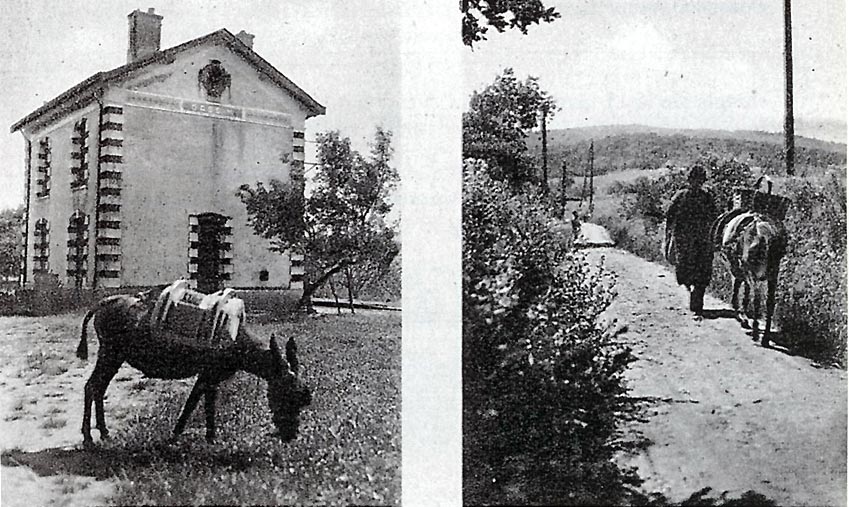
The PTT used a donkey to take the mail up and down from the station to the village..
Inaugurations
The official inauguration took place on Sunday, August 25, 1889 with a triumphal reception in Sainte Maxime and La Foux where the mayor of Saint Tropez made a speech wishing a rapid realization of a branch to his town.
On Thursday, September 19, 1889, the section La Foux-Saint Raphaël was opened to exploitation. 3 mixed freight/passenger trains provided daily service in both directions.
On April 19, 1890, following very heavy rains, the waters caused breaches in the embankment crossing the plain of Grimaud: a transhipment on foot of passengers had to be established for several days in order to repair the track.
From July 1 to 9, 1890, the metering of the La Foux-Hyères section was carried out: 53,159m0. On July 22 and 23, a heavily ballasted train carried out the load tests of the metal bridges.
The official inauguration took place on July 25, 1890 and the line was opened to passengers on Monday, August 4, 1890. The success was immediate except for the goods which were delayed. Additional facilities had to be created as soon as possible in order to adapt to the evolution of traffic.
Numerous modifications had to be made to the line following incidents caused by violent weather conditions that had not been foreseen: many bridges were added (3 in the Grimaud plain) to prevent the embankments from damming up the water in times of flooding.
|
THE 'CASE' of Compagnie du Sud
Baron de Reinach, implicated in the Panama Canal scandal, committed suicide on 20 November 1892. In 1894, the President of the Republic Sadi CARNOT was assassinated by an anarchist and the trial of Alfred Dreyfus accused of treason opened in a poisoned atmosphere. It was during this period that the Southern Railway affair, which was then called as important as the Panama Canal affair, broke out: influence peddling, intimidation, bribes, corrupt politicians!
Félix Martin, the benefactor of the French Riviera, was arrested and imprisoned on January 3, 1895. On the 5th, he was dismissed from his position as mayor.
The affair lasted until the end of 1995 and quietly died out after Felix Martin's acquittal.
|
Bad weather
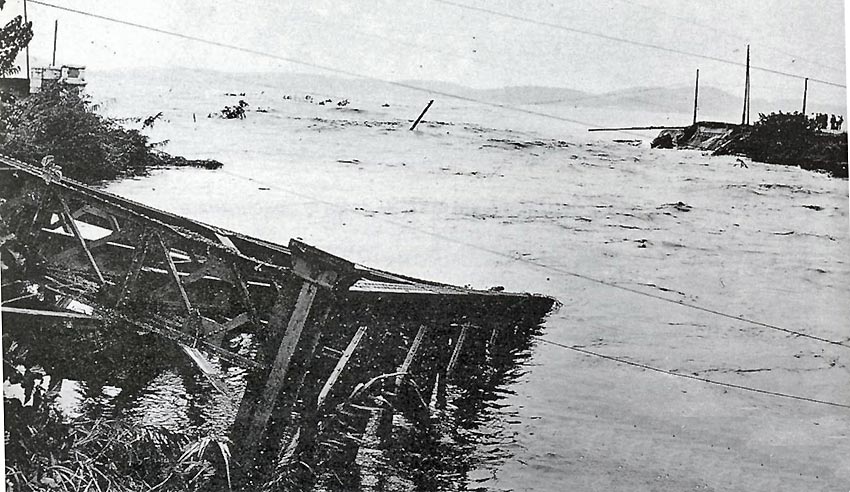
On September 29, 1932, a particularly violent tidal wave and torrential rains caused the rivers to overflow and swept away the two bridges spanning the Preconil. It was following this catastrophe that the road bridge was rebuilt with the 2 arches that still adorn it today.

A bridge was temporarily built on the Préconil by the sappers of the 7th Engineer Regiment. Train traffic was interrupted from October 1932 to October 1933 until the construction of a new bridge. 2 coaches and a truck ensured the transshipment of passengers and goods from La Foux to Ste Maxime.
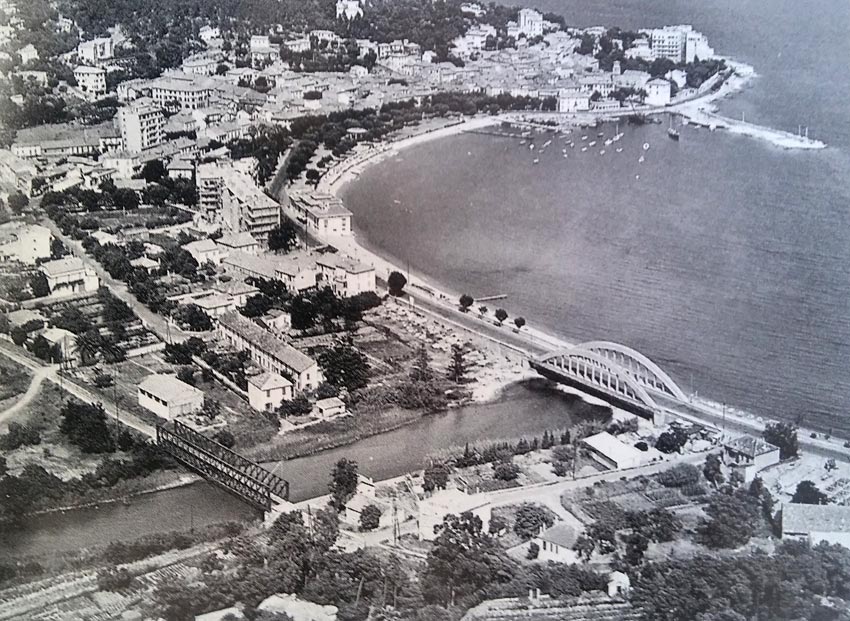
In 1933 the 2 bridges of Sainte Maxime were rebuilt (collection Raymond BERNARDI).

The TRAMWAY COGOLIN / SAINT TROPEZ

The first tramway linking La Foux to Saint Tropez and La Foux to Cogolin.
On August 31, 1887, the General Council approved the route of hyères / Saint Raphaël, and asked the company to study a junction from La Foux station to Saint Tropez and another to Cogolin.
A preliminary project was presented on April 11, 1888, which was very economical since it took the shoulder of the road.
On December 17, 1889, a concession agreement signed between the department and the SF company provided for the future line to be classified as a "tramway" rather than a "local-interest railway". The advantages of such a classification were mainly economic, since it allowed the railway to follow the road route, with simplified installations compared to a railroad for trains, and the use of small-gauge rolling stock with a speed limit of 20 km/h.
The administrative formalities lasted 2 years until a new convention was signed on April 9, 1892 and approved by ministerial decision on July 13, 1892.
Strange paradox of the French legislation, the concession of the line Toulon / Saint Raphaël, 81 km. had to be granted by the department whereas the concession of Saint Tropez / Cogolin, 9 km. had to be granted by the state since using the edge of a national road, the N98!
It was therefore necessary to establish a concession by the state to the department which retroceded it to the operating company...
Construction work began in April 1894 and progressed very quickly...

Small bridge spanning the Garcinières valley, at the exit of Cogolin.
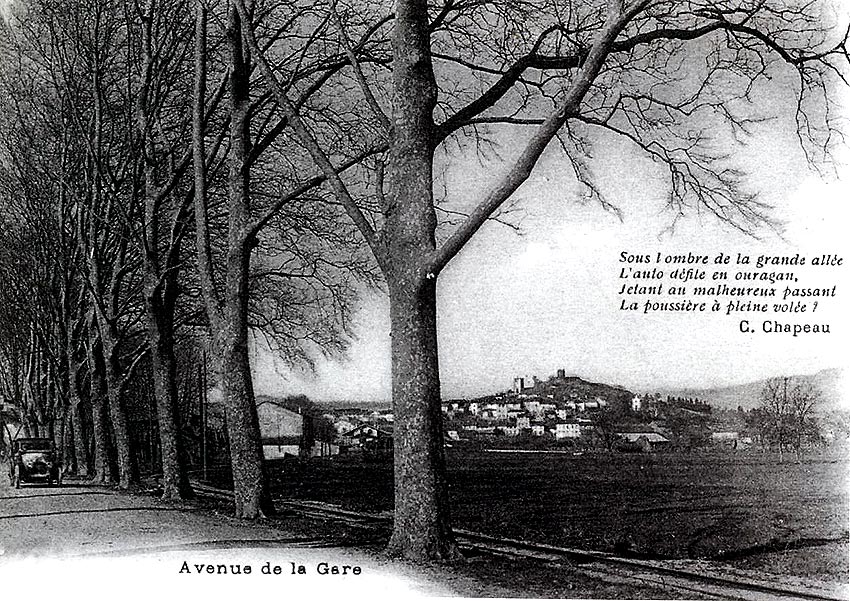
The track runs along the lower side of the road. We discover Cogolin in the distance.
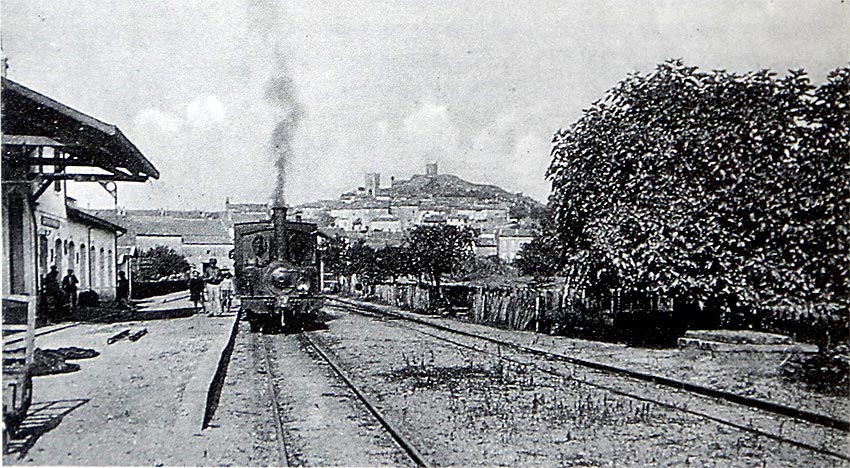
The station of Cogolin from where a stagecoach left for Grimaud and La Garde Freinet.
In the direction of SAINT TROPEZ
In the Bertaud district, the road leading to Saint Tropez and the tramway passed on each side of a gigantic umbrella pine, which has become famous. Its trunk reached 2,45m. of diameter, that is to say more than 7m. of circumference!
In his book "Côte d'Azur" Stéphen Liégeard wrote about this umbrella pine: "The most beautiful in the world. This colossus deserves a pilgrimage to its destination! Visible from every corner of the countryside, it covers paths and fields with its mobile soul." But that was before the tramway line was created...
Unfortunately, this majestic and hundred-year-old tree was scandalously felled in 1928 because its strong roots deformed the foundation of the railway.
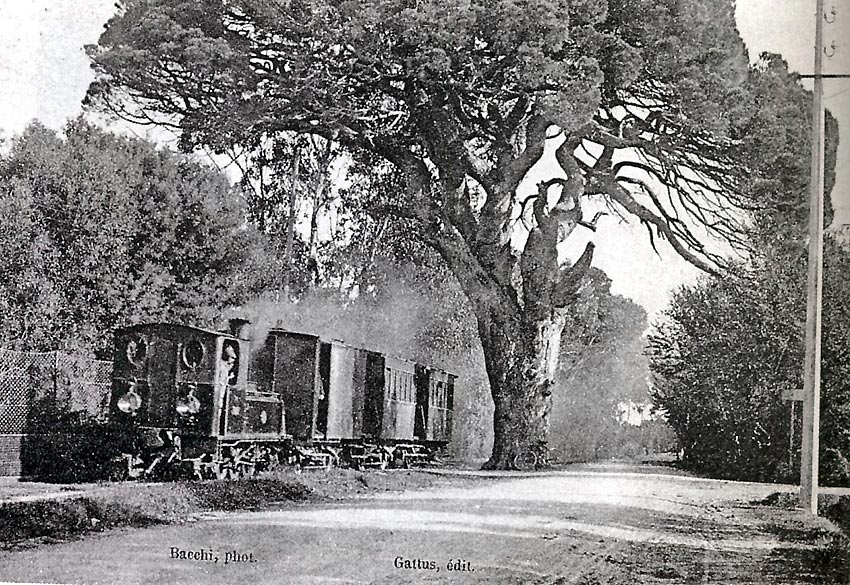
The railway passes on one side of the Bertaud pine and the road on the other...
Le Pin BERTAUD
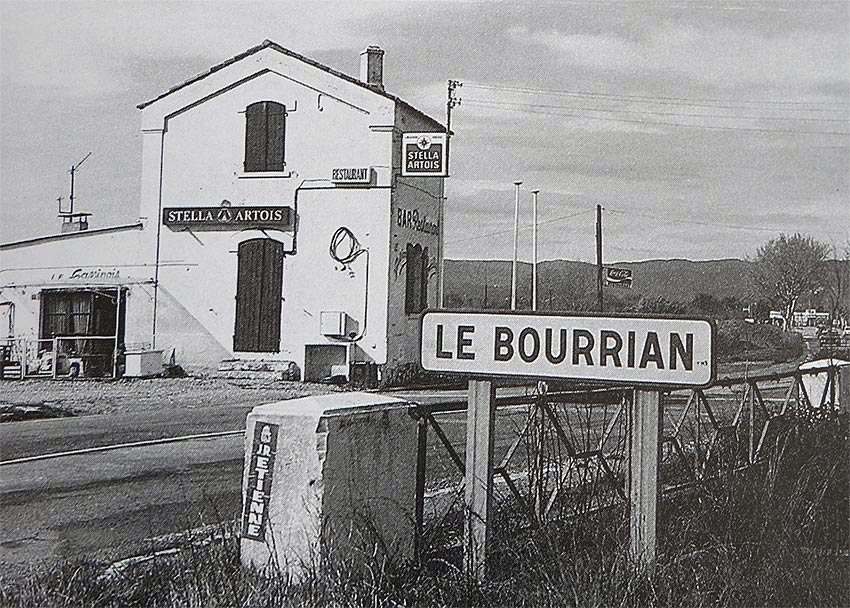
This small house, former house of a level crossing still exists.
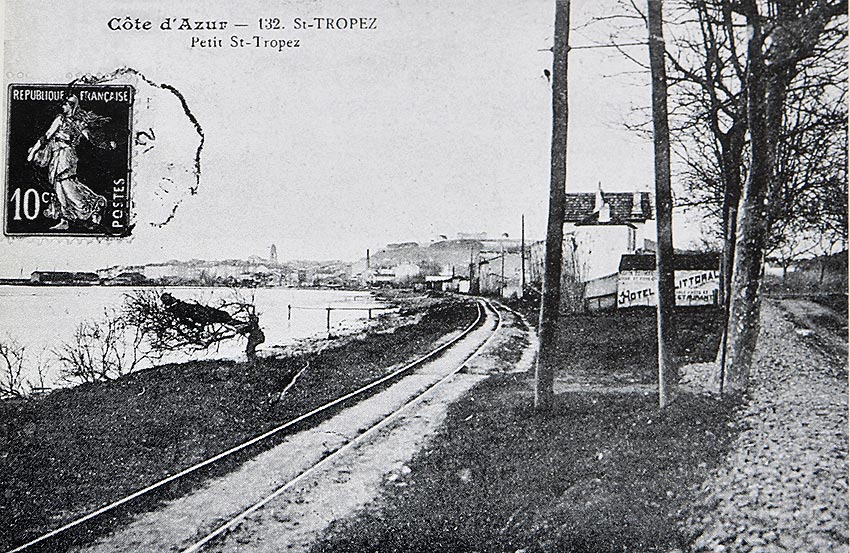
The arrival in Saint Tropez
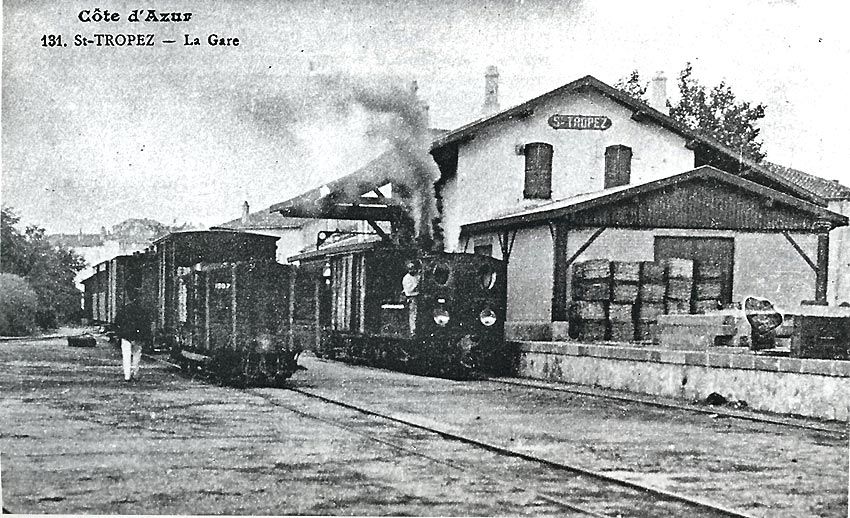
Saint Tropez station
The terminals of Cogolin and Saint Tropez were built as well as the extension of the Foux train station. On June 26th the metal bridges built by the Cartairade company from Marseille were tested.
On June 27, a special reconnaissance train circulated between Saint Tropez and Cogolin at an average speed of 20 km/hour.
It was necessary to add a swing bridge at each terminus and create a port spur in Saint Tropez. This road, about 200m long, went as far as the Quai de l'Epi, thus allowing goods, cork, cork, mine wood and sand from the Foux, to be loaded onto boats leaving for other Mediterranean ports.
The line was opened for operation on July 1, 1894. Four daily shuttles ran in each direction, providing connections with the Toulon / Saint Raphaël line.
Women constituted up to 30% of the staff of the Littoral network (gatekeepers, station managers).
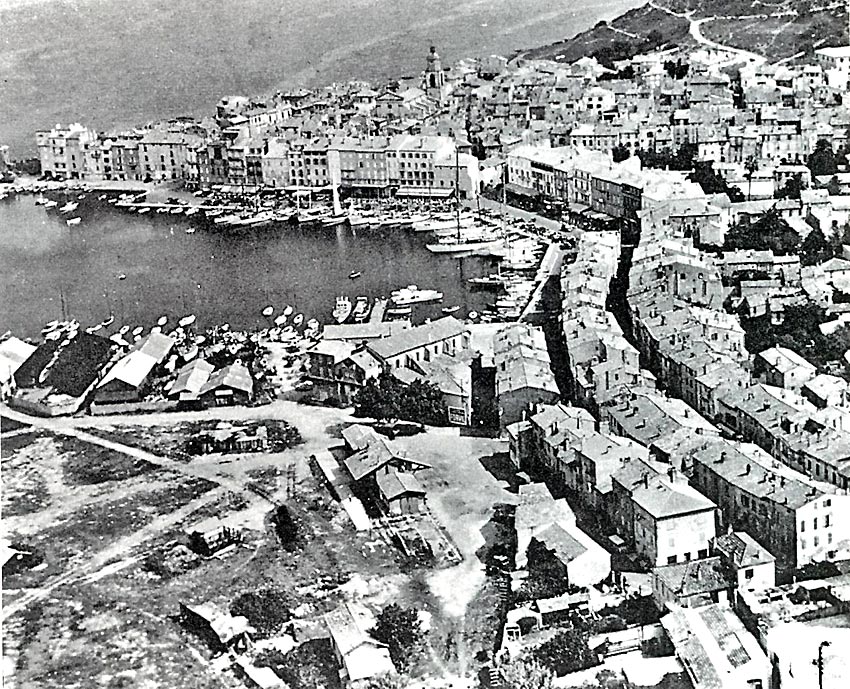
(Photo E.W. ROBINSON)
Aerial view of the port of Saint Tropez in 1950: The buildings of the old train station are still in place. In their place will be built the post office. The tracks have been dismantled but we can guess their layout and the junction towards the port.
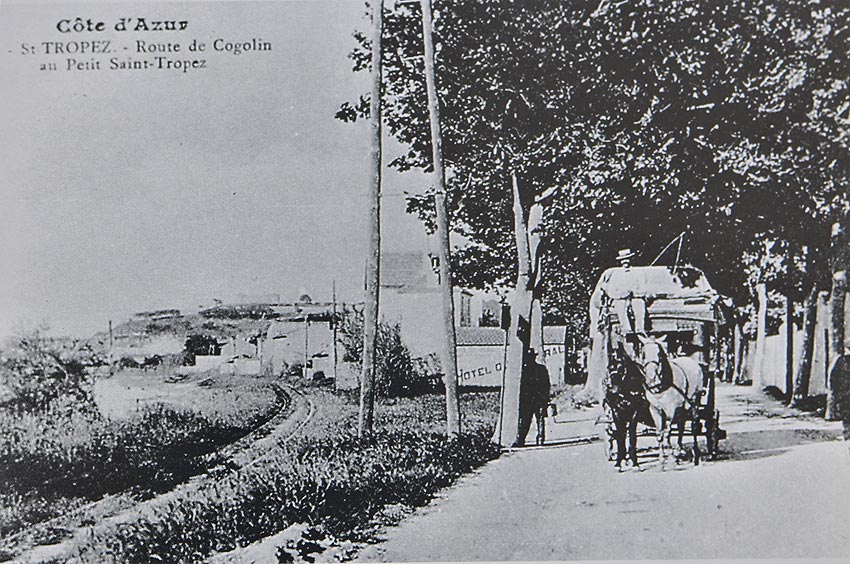
A stagecoach provided the shuttle from the Saint Tropez train station to Ramatuelle.

Coach having replaced the stagecoach to provide the shuttle between Saint Tropez station and Ramatuelle around 1930.
Profitability
3 locomotives and 6 cars were assigned to this line, plus freight cars that continued on Hyeres or Saint Raphaël.
As soon as it went into service, the Cogolin / Saint Tropez tramway line became the most profitable of all those operated by the company in the South of France. (SF).
For its first year, the average mileage revenue was 4730F. against 3315F. for the Littoral line, 3206F. for the Alps network and 2538F. for the Cote d'Or network.
In view of the success of the tramway but also of the economic impact that the coastal train had, Dr Sigallas, Senator and Councillor of Grimaud, at the General Council session of October 10, 1902, voted on a study in principle for the creation of a local interest network with a 60 gauge track, with the creation of a Cogolin / La Garde Freinet / Gonfaron line.
On November 15, 1904, the same Council studied a metric route linking Cogolin to Garde Freinet via Grimaud.
On November 27, 1908, the Var General Council signed an agreement for the definitive sale of a Cogolin / La Garde Freinet line (15km.) with the SF.
In 1910 the SF began the expansion of the Cogolin railway station. In 1911 the studies of the route began with the survey of the bridge locations and the purchase of land.
The final draft was approved by the General Council on September 11, 1913. It foresaw a total length of 15,612km. The line followed the shoulder of the road from Cogolin to Grimaud, up to the station to be created in Grimaud, then penetrated under a 90m. tunnel before following a severe ramp to the Bérard stop, then making an S-shaped loop around the hill of Notre Dame de Miremer, to arrive at La Garde Freinet, the old Saracen den, at an altitude of 344m.
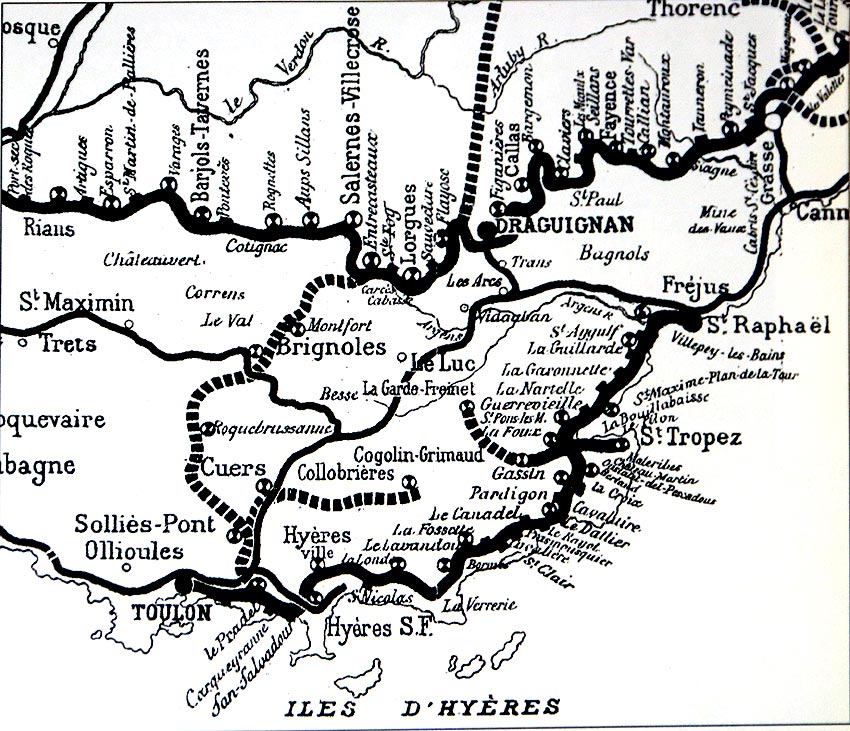
Plan of existing lines and lines being created
The Joseph Fontana company of Nice was in charge of the infrastructure work and started the works on July 1, 1914.
A month later, war was declared...
Tourist numbers stopped, causing a sharp drop in traffic on the coast. The average revenue went from 7396F. to 2597F. on the Cogolin / Saint Tropez line.
The torpedo factory
Fortunately, in 1912, the French Whitehead Torpedo Company, a subsidiary of the British group Armstrong-Vickers, set up an armaments factory on the road to Saint Tropez, at the place called BERTAUD, without using the railway. But the increase in its activities due to the war forced it to hire several hundred workers and to ask the SF to start up specialized trains to transport personnel.
On November 1, 1915, two additional shuttles were put into service to transport some 300 subscribers, but soon proved insufficient to provide this service. Open carriages had to be added but the engines could not handle the extra weight. The more powerful machines of the main line were authorised to run to Saint Tropez as early as January 1916.
By July 1916 the number of subscribed workers had risen to 400!
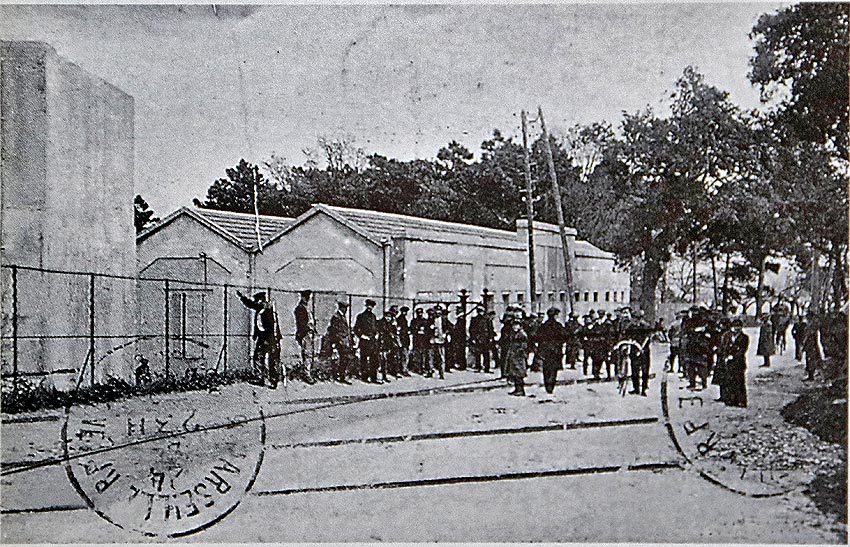
The workers at the Torpilles factory are waiting for the tramway.
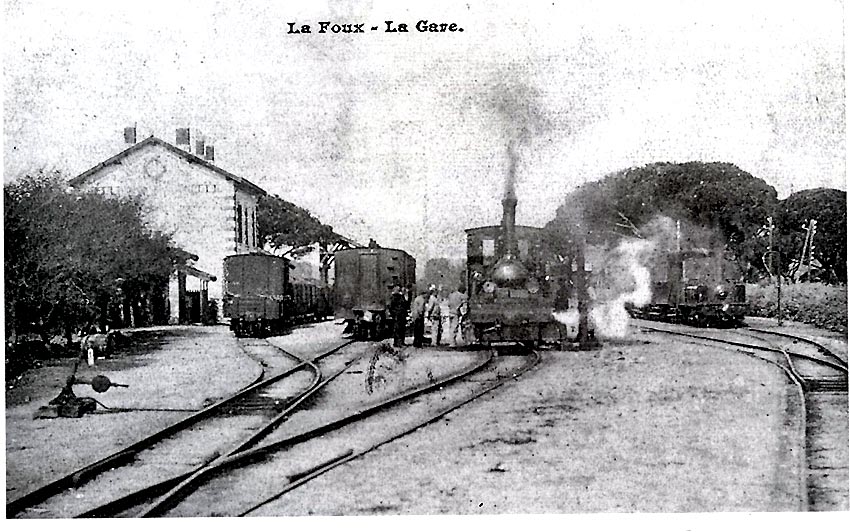
La Foux station and its many tracks
The war
With the war, work on the Cogolin / La Garde Freinet line, although well under way, was suspended in February 1915 and never resumed despite the efforts of the General Council.
At the end of the war, the financial situation of the SF was at its lowest point. During the interwar period, there was a build-up of conflicts between the SF and its interlocutors, the General Council, the State, the often dissatisfied users, but also the staff now represented by trade unions. The equipment that had suffered during the war was slow to be renewed and modernised. So were the works and the track, with the reduction in personnel and maintenance.
A new agreement was signed between the Prefect of the Var and the SF in order to relaunch and modernise the operation of the Littoral line, expressing the wish for its electrification.
The SF took the opportunity to change its name to Compagnie des Chemin de Fer de la Provence on 1 January 1925. (CP).
From 1925, a resurgence of traffic materialised, but as staff conditions deteriorated, a general strike blocked all traffic in October 1928.
The General Council and the Prefect of the Var urged the company to respect its staff. The Saint Tropez City Council resigned to show its support for the railway workers on strike.
The conflict lasted 55 days and left indelible traces between the company, the administrations and the staff . The company's deficit increased with the global economic crisis and strong competition from the road with tourist coach connections.
The tidal wave accompanied by torrential rains and floods of 28 September 1932 did not help matters. In the daily newspaper "Le Petit Provençal" of October 1, 1932: "The railway line of the Chemins de fer de Provence no longer exists from Gassin to Sainte Maxime, so to speak".
The damage caused to the entire Toulon Saint Raphaël line was estimated at 4,890,000 francs, i.e. the revenue for one year of operation.
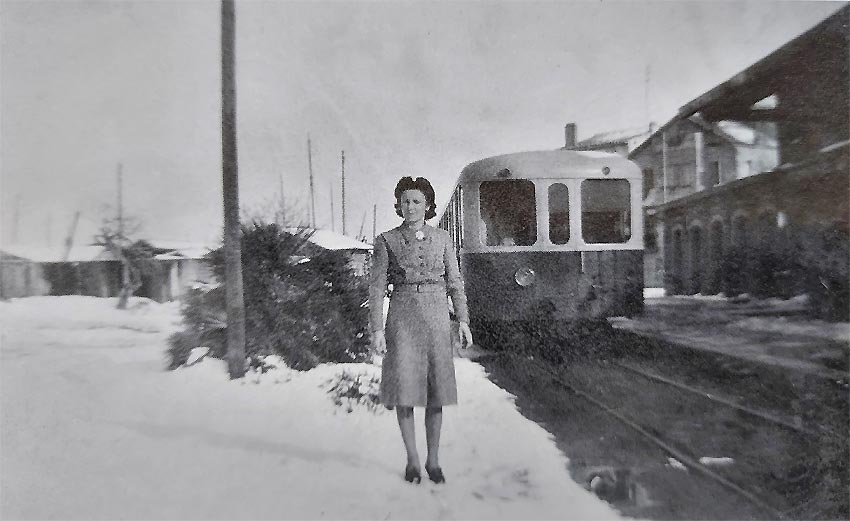
The last model of the tramway, here in Saint Tropez, 2 days before the closure of the line on 4 June 1949.
On 25 October 1933, the General Council, anxious to modernise a vital coastal line for the region, gave its support to the CP company by deciding to acquire 10 diesel self-propelled 200 hp motorcars. Their delivery began in March 1935.
From 1st July 1935, the passenger service between Toulon and Saint Raphaël was entirely provided by railcars, which resulted in a significant increase in passengers. From the summer of 1936, paid holidays gave even more activity to the Littoral line and the Saint Tropez line, where shuttle buses came to help the flow of traffic.
CP took advantage of its improved situation to supplement its rail traffic with a coach service.
Real hopes of prosperity seemed to open up for the Coastal Railway when World War II was declared on 3 September 1939.

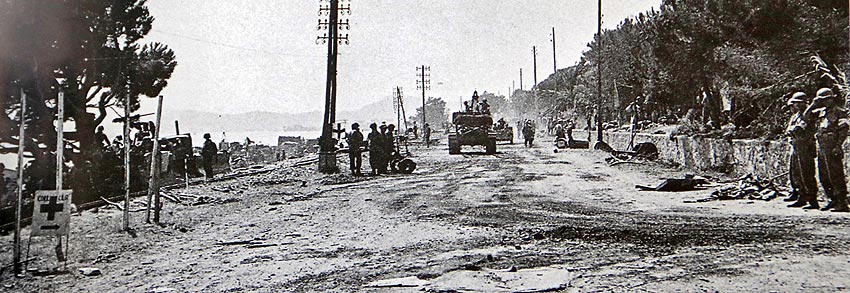
15 August 1944: the line is practically buried under the rubble at the exit of Sainte Maxime while the French troops land in the Gulf of St Tropez.
After many bombardments and the fortification of the coastline in the spring of 1944, traffic was considerably reduced.
On 1 April 1944, all the inhabitants of La Foux were evacuated to Cogolin.
On 9 April, the Foux railway station was completely destroyed along with the neighbouring hippodrome and the majestic pine forest that extended to the current location of Port Grimaud.
On 15 April, there were no civil or private buildings left standing and no majestic trees in the La Foux district.
On release, train operations are totally suspended. Several kilometres of line are impassable.
On 5 September, some of the staff regrouped to return to work.
On 18 November, the government granted an exceptional allocation of 4,600,000 francs to the company to compensate for its financial difficulties.
The tracks that had suffered much damage were repaired as best they could and on 15 March 1945 traffic was able to resume. But the difficulties of the company worsened.
On 31 July 1946, the General Council decided to replace the dilapidated railway network with a road network.
At the beginning of 1948, the company gave more and more priority to the road and installed garages for its coaches in Toulon and Saint Tropez.
In spite of many defenders of the line who expressed their disapproval, the company abandoned the railway in favour of the road.
On 31 July 1946, the General Council decided definitively to replace the network with a public road service.
The "Petit Varois" wrote the next day "A not very pretty page has been turned in the history of our department".
The network was no longer maintained and on October 18, 1948, with general indifference, a last train ran between Toulon and Hyères.
The La Foux / Saint Tropez workers' service continued for another eight months until 4 June 1949, when the tramway line was definitively closed.
The coastal network has been closed for many reasons, but not because of a lack of travellers. !

From 1947 onwards, buses gradually replaced the coastal train... Here a Renault 215-D in front of Saint Tropez station...
|
Development of the region
The coastal train had the great advantage of revolutionising the closed environment of the Maures massif by creating and promoting intense commercial, industrial and tourist activity, allowing small villages to become popular holiday and resort sites. If the silkworm industry collapsed, viticulture, market gardening and flower growing, forestry and fishing found, thanks to the train, many outlets for their products.
The population increased allowing hamlets such as La Croix Valmer in 1934 or Cavalaire in 1929 to become autonomous communes by detaching themselves from Gassin, or like Le Rayol-Canadel in 1949 to the detriment of La Môle.
The life of the peasants, fishermen and the whole population of this region has profoundly changed and evolved towards new professions linked to tourism: hotels, restaurants, shops, domestic jobs at the service of the rich tourists irresistibly attracted by the Mediterranean...
|
La ligne
La Foux station (called "Cogolin-Saint Tropez" until 1894): opened in 1889, 2 main roads and a goods road. Then 2 additional tracks in 1893, for the Cogolin / Saint Tropez tramway.
St Pons Les Mures station (called "Grimaud" until 1904): opened in 1889, one main and one freight track. In 1903, creation of a siding on the St Raphaël side. In 1907, construction of a goods hall.
Gassin-Ramatuelle station ("Gassin" originally): opened in 1890, one main road, a goods road and a siding on the Hyères side.
Cogolin-Grimaud station ("Cogolin" until 1904): opened in 1894, 2 main tracks, one goods, warehouse for one machine, tramway building and goods hall. In 1912, extension of the buildings and the goods platform, creation of a garage track.
Stop of Les Garcinières and Stop of Chemin de Grimaud ("Grand Pont" until 1896): opened in 1894. In 1902, the stop at Les Garcinières was moved 400m towards Cogolin.
Stop of Bertaud, stop of Usine-de-Bertaud and stop of Oustalet-dei-Pescadous: opened respectively in 1894, 1915 and 1904.
Château-Martin and Sinopolis: opened in 1894 and 1937.
Stop of Maleribes and of la Bouillabaisse:opened in 1895 and 1894
Stop of Pilon: opened in 1896.
Sablière de La Foux Branch : Opened in October 1899 by the company Suvéran frères de Marseille, on the site of the Avenue de la Mer leading to Port Grimaud. For about ten years, the wagons loaded with sand were directed towards Saint Tropez for embarkation for Toulon or Marseille.
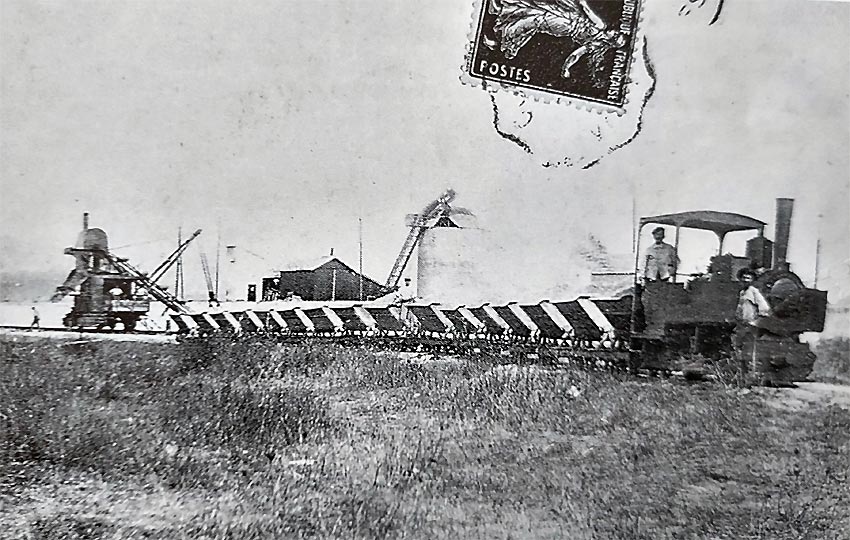
Sandpit train consisting of a set of tipper wagons.
Saintons-les-Mures branch line : to allow the transport of porphyry extracted from a nearby quarry. The wagons were pulled by horses.
Spur serving the Quai de l'Epi in Saint Tropez: built in 1900, 200m long, and splitting into two dead-end lanes and a third giving access to the Navy's fulmi-cotton (explosives) reserve and the Labourdette & Béroard cork stopper factory. From these junctions, cork, cork stoppers, mine wood and sand from La Foux left for other Mediterranean ports.
The accident
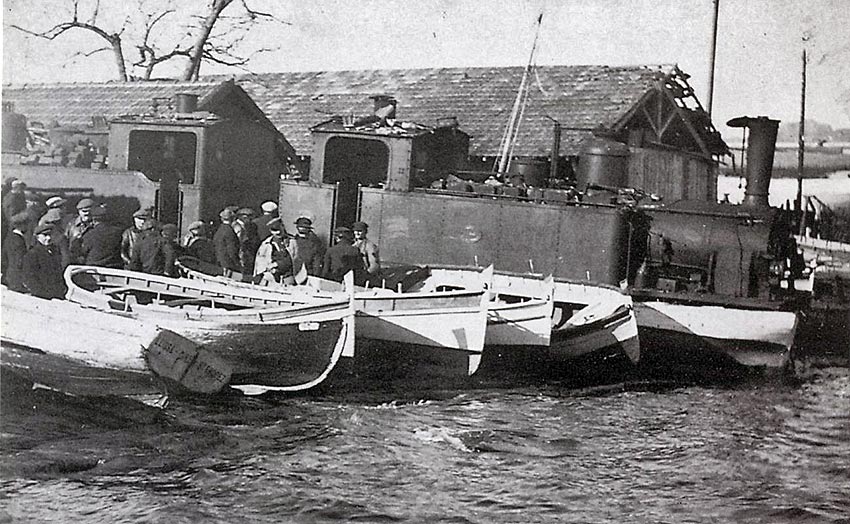
In December 1923, a locomotive finished its race in balance on the quay of the port of Saint Tropez.
Publicité
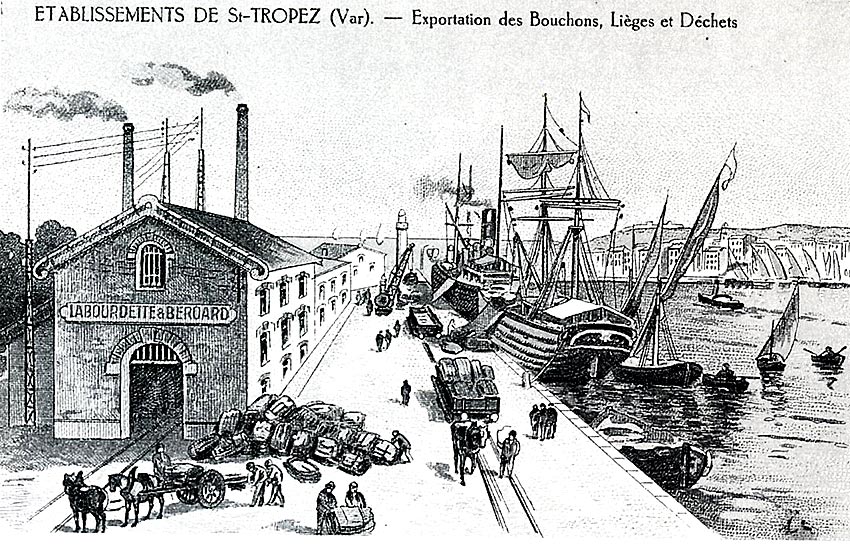
Advertising postcard of the Labourdette & Béroard cork factory installed on the Quai de l'Epi and which has since disappeared.
|
FIRE
From 1880 to 1931: Charcoal locomotives set fire to the forests of the Var region..
The Var had an area of 600 000 ha with 297 000 ha of forest. But between 1880 and 1929 fire destroyed thousands of hectares of forest. And it has been evaluated, at that time, that the "escarbilles" (these small fragments of fuel incompletely burnt and transported by the wind) of the coal locomotives caused 34% of these fires!
|
PLANS of the stations
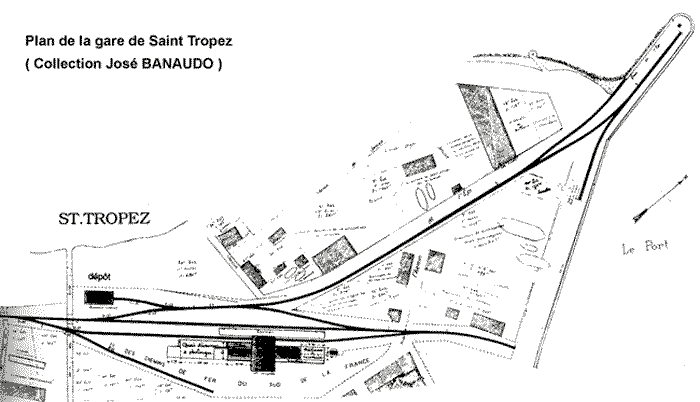
St Tropez railway station

Cogolin railway station

La Foux main railway station

|
ACKNOWLEDGEMENTS
This history has been created thanks to the documents of the Groupe d'Etude pour les Chemins de Fer de Provence and to the book that I invite you to read if you are interested in the railways of Provence: "Le TRAIN du LITTORAL" by José BANAUDO at "Editions du Cabri" in the collection "Histoire des Chemins de fer de Provence -2".
photos : Marcel CAUVIN (collection Hidalgo ARNERA). Collections Jean Pierre VIGUIE, Raymond BERNARDI, G.E.C.P., Jean Paul PIGNEDE, Edmond DUCLOS, Jean BAZOT, Document U.S. National Archives & Records Administration.
|
|